Sustainable fashion is not exclusive; it is becoming more accessible to everyone. Although higher quality pieces may come with a higher initial price tag, they often last longer and end up costing less per wear. Additionally, many brands are offering innovative payment plans to help make ethical fashion more affordable. You can also discover reasonably priced sustainable options and second-hand treasures that reduce waste without emptying your wallet. This movement promotes conscious consumption and advocates for fair labor practices. If you’re interested in learning more about how sustainable fashion is transforming the industry, there is a lot more to learn.
Key Takeaways
- Sustainable fashion often carries higher price tags due to eco-friendly materials and ethical labor practices, which can alienate budget-conscious consumers.
- Fast fashion thrives on economic disparity, while sustainable fashion promotes class solidarity through fair wages and ethical sourcing.
- Innovations in payment options, like Klarna and Afterpay, make sustainable fashion more accessible, challenging the elitist perception.
- The shift towards quality over quantity encourages mindful purchasing, allowing consumers to invest in lasting pieces that reflect their values.
Elitism in Sustainable Fashion
Elitism in sustainable fashion often arises from the higher price tags of ethical brands, which reflect the cost of eco-friendly materials and fair labor practices. You might perceive these sustainable fashion brands as exclusive, catering only to a privileged few.
The reality is that while the initial investment can be steep, ethical fashion often offers lower cost-per-wear when you consider durability and timelessness.
Smaller brands frequently face challenges in sourcing materials and obtaining certifications, which can further hike their prices. This creates a fashion elitist vibe that can discourage many from participating in sustainable practices.
However, it's essential to recognize the growing availability of reasonably priced sustainable options and second-hand marketplaces that make eco-friendly choices accessible to everyone.
Additionally, payment innovations like Klarna and Afterpay are reshaping the landscape, enabling you to spread out the costs of higher-priced items. This shift challenges the elitist perception, making it easier for all consumers to embrace ethical fashion.
Elitism in Traditional Fashion
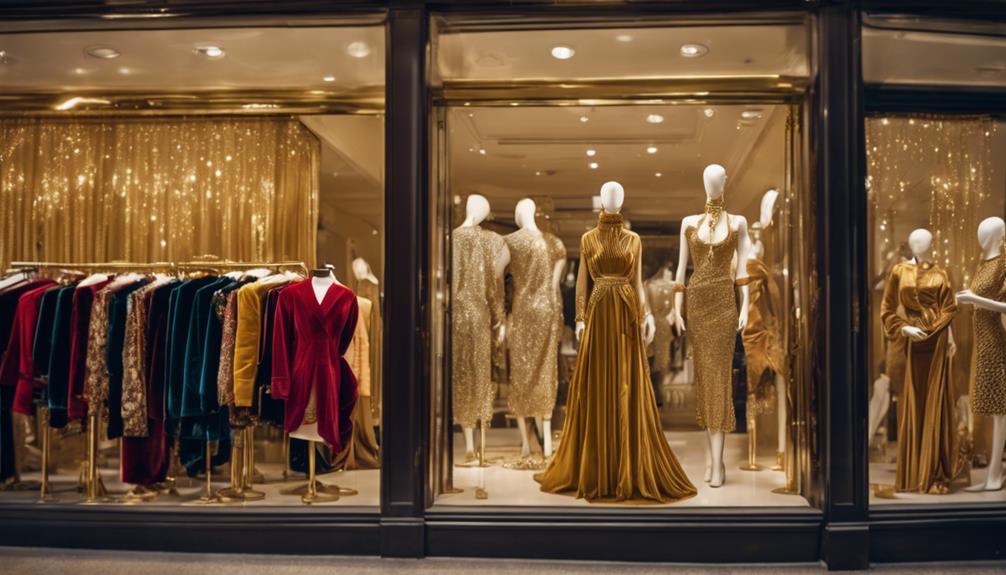
In traditional fashion, a sense of exclusivity emerges as fast fashion brands manipulate consumer insecurities, pushing you to constantly chase the latest trends. This dynamic fosters elitist consumer behavior, making you feel inadequate if you don't keep up with the ever-changing styles. Social media amplifies this pressure, with influencers showcasing outfits that reinforce the notion that only the newest pieces are acceptable.
Shopping itself becomes a social activity, often alienating those with limited budgets. While some can afford to indulge, others find themselves sidelined, reinforcing a culture that values exclusivity over inclusivity. Fast fashion brands thrive on this cycle, producing garments designed for short-term use, which leads to frequent repurchases.
Ultimately, this disposable culture not only burdens lower-income consumers but also contributes to environmental degradation. The sustainability movement aims to challenge these harmful practices, yet traditional fashion's elitist implications continue to overshadow genuine efforts for change.
You're left wondering how to break free from this cycle, realizing that true fashion should celebrate individuality and sustainability, rather than perpetuating a need for constant consumption and conformity.
Class Solidarity and Fast Fashion

Fast fashion might seem like a budget-friendly choice, but it actually traps you in a cycle of economic disparity and exploitation.
While it offers immediate accessibility, it comes at a hidden cost to both workers and the environment.
You should consider how your clothing choices impact not just your wallet, but also the broader community and sustainability efforts.
Economic Disparity and Exploitation
Affordable clothing may seem like a blessing for lower-income consumers, but it often comes at a heavy cost to both exploited workers and the environment. Fast fashion thrives on economic disparity, where low prices are made possible through the exploitation of garment workers. This creates a vicious cycle that traps many in poverty while promoting an unsustainable consumption model.
Fast fashion perpetuates poor working conditions and inadequate wages for workers. Cheap clothing leads to higher long-term costs due to poor quality and frequent replacements. Economic constraints can glamorize fast fashion despite its harmful impacts. Sustainable fashion prioritizes fair wages, community health, and ethical practices.
You might think that affordability is key, but the true cost of fast fashion is hidden in the exploitation behind those low prices. Supporting sustainable fashion isn't just about being trendy; it's about advocating for class solidarity and recognizing the human cost of your choices.
Accessibility Vs. Sustainability Debate
Many consumers face a tough choice between the immediate satisfaction of fast fashion's low prices and the long-term benefits of sustainable options that promote class solidarity and ethical practices. While fast fashion seems accessible, it is crucial to recognize its hidden costs. You might think you're saving money, but the cycle of low-quality garments necessitates frequent purchases, ultimately straining your budget.
Here's a quick comparison:
| Aspect | Fast Fashion | Sustainable Fashion |
|---|---|---|
| Price | Low initial cost | Higher initial investment |
| Quality | Low durability | High durability |
| Long-term Impact | Economic strain | Promotes class solidarity |
Fast fashion perpetuates poverty and exploitation, making it a tempting yet harmful choice. Sustainable fashion is often labeled elitist, but this overlooks the value of buying less and investing in quality items. By shifting your mindset to prioritize longevity and mindful purchasing, you can contribute to a more ethical industry. Remember, you hold the power to choose fashion that supports both your budget and the well-being of garment workers.
Sustainable Fashion as a Mindset

Sustainable fashion isn't just about buying new eco-friendly items; it's about changing how you think about your wardrobe.
By prioritizing quality over quantity and embracing repeat outfits, you can make mindful purchases that reflect your values.
This mindset not only benefits the environment but also challenges the idea that sustainable fashion is only for the elite.
Embracing Repeat Outfits
Embracing repeat outfits not only reduces waste but also encourages a mindful approach to your wardrobe choices. By consciously choosing to wear the same pieces multiple times, you're stepping away from the cycle of fast fashion and making a sustainable statement.
This mindset can lead to a more versatile and creative wardrobe, allowing you to express your personal style without succumbing to societal pressures.
Here are some benefits of embracing repeat outfits:
- Sustainability: Each time you wear an item, it extends its life and reduces the demand for new purchases.
- Cost-Effective: You save money by investing in fewer, higher-quality pieces that you love.
- Unique Style: Repeating outfits lets you experiment with different accessories and combinations, showcasing your creativity.
Prioritizing Quality Over Quantity
Prioritizing quality over quantity transforms your approach to fashion, encouraging a more thoughtful and intentional relationship with your wardrobe. Instead of chasing fleeting trends, you start investing in high-quality, sustainable pieces that last longer. This not only reduces waste but also enhances your overall style.
| Aspect of Fashion | Quality Focus | Quantity Focus |
|---|---|---|
| Durability | Lasts years with care | Worn a few times and discarded |
| Cost-per-wear | Lower cost over time | Higher cost due to frequent replacements |
| Environmental Impact | Reduces waste considerably | Contributes to textile waste |
| Personal Style | Unique, timeless pieces | Generic, trend-driven items |
Mindful Purchasing Practices
Mindful purchasing practices reshape your fashion choices, encouraging you to invest in quality pieces that align with your values and reduce waste. By embracing this mindset, you not only enhance your wardrobe but also contribute positively to the planet.
Here are some key aspects to contemplate:
- Invest in Durability: Choose garments made from sustainable materials that last longer, saving money in the long run.
- Buy Second-Hand: Explore thrift stores or online platforms for upcycled clothing, offering you affordable options while promoting sustainability.
- Embrace Repeat Outfits: Don't shy away from wearing your favorite pieces multiple times; it reflects personal style over fast fashion's fleeting trends.
Accessibility of Ethical Brands
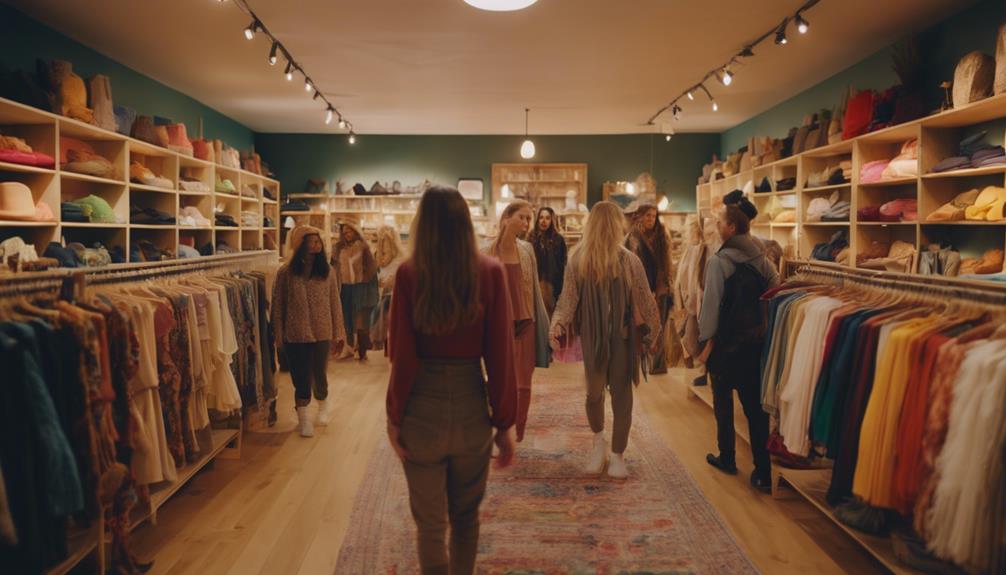
Accessing ethical fashion doesn't have to break the bank, as many brands offer sustainable options at various price points. While it's true that ethical brands often come with higher price tags due to eco-friendly materials and fair wages, this doesn't mean sustainable fashion is only for the wealthy. You can find a range of reasonably priced options that challenge the idea that you need disposable income to afford ethical clothing.
Consider the long-term benefits of investing in these pieces. The cost-per-wear can actually be lower when you wear garments multiple times, making them a smart choice. Plus, second-hand shopping provides even more affordable options for those seeking sustainable styles without overspending.
Innovative approaches to shopping are also helping make ethical brands more accessible. By exploring various sources, you can discover brands that fit your budget, proving that sustainability isn't just for an elite few.
Innovations in Payment Options

Innovative payment options like Klarna and Afterpay are making sustainable fashion more accessible by allowing you to spread the cost over time. This means you can afford higher-priced ethical clothing without the financial strain typically associated with such purchases.
These innovations in payment options help remove the upfront cost barrier, enabling a broader audience to invest in sustainable fashion.
Here are some key benefits of these flexible payment solutions:
- Interest-free installments: You won't pay extra fees by splitting your payments.
- Encourages quality purchases: You can prioritize sustainable, ethically sourced items over fast fashion.
- Supports diverse consumers: More people can participate in ethical shopping, breaking the elitist stereotype.
Supporting Ethical Labor Practices
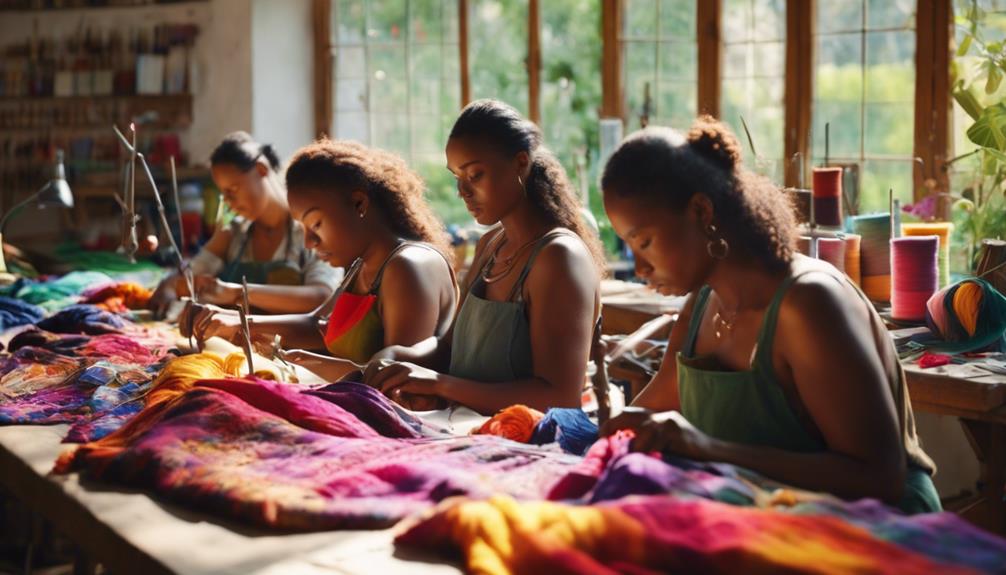
When you choose sustainable fashion, you're not just investing in unique garments; you're supporting fair wages and safe working conditions for all.
Transparency in sourcing helps you understand where your clothes come from and the impact of your choices.
Fair Wages Matter
Prioritizing fair wages guarantees that workers in the sustainable fashion industry are compensated fairly for their skills and contributions. When you choose ethical clothing, you're supporting not just the environment but also the livelihoods of those who create these garments.
Here are a few reasons why fair wages matter:
- Empowerment: Fair compensation empowers workers, helping them support their families and communities.
- Quality Assurance: Well-paid workers are more likely to produce high-quality garments, enhancing your investment in sustainable fashion.
- Ethical Standards: Supporting brands that prioritize fair wages promotes ethical labor practices across the industry.
Sustainable fashion often comes with higher price points, but this reflects the true value of the craftsmanship and ethical labor behind each piece.
By choosing brands that prioritize fair wages, you're making a statement about the kind of fashion you believe in—one that values people and the planet.
Ultimately, your choices can drive change and support a more equitable industry.
Transparency in Sourcing
Fair wages are just one part of the equation; transparency in sourcing guarantees that every step of the production process reflects ethical labor practices, giving you confidence in your fashion choices. When you choose sustainable fashion brands, you support a movement that prioritizes not just the environment but also the people behind the products. These brands often invest in third-party certifications, ensuring that the materials and labor meet stringent ethical standards.
Here's a quick comparison to highlight the benefits of transparency in sourcing:
| Aspect | Traditional Fashion | Sustainable Fashion Brands |
|---|---|---|
| Labor Conditions | Often hidden | Clearly outlined |
| Certification | Rarely available | Common (Fair Trade, GOTS) |
| Worker Treatment | Exploitative | Ethical |
| Environmental Impact | Negligible | Actively managed |
| Consumer Trust | Low | High |
Community Empowerment Initiatives
Community empowerment initiatives actively support ethical labor practices by uplifting artisans and small businesses, guaranteeing they receive fair wages and work in safe conditions.
When you choose sustainable fashion, you're not just making a style statement; you're also contributing to a movement that prioritizes people over profit. By supporting sustainable fashion, you are supporting brands and designers who prioritize ethical sourcing, fair labor practices, and environmentally friendly production methods. When you invest in clothing from a sustainable fashion designer, you are investing in clothing that is made to last, reducing the need for constant repurchasing and minimizing waste. Ultimately, choosing sustainable fashion is not just a matter of personal style, but a conscious decision to support a more ethical and environmentally friendly fashion industry.
Here's how these initiatives make a difference:
- Fair Wages: Artisans earn a living wage, allowing them to support their families and communities.
- Safe Working Conditions: Ethical labor practices guarantee that workers operate in environments free from hazards.
- Preservation of Craftsmanship: Supporting local artisans helps maintain traditional skills and cultural heritage.
Environmental Impact of Consumption
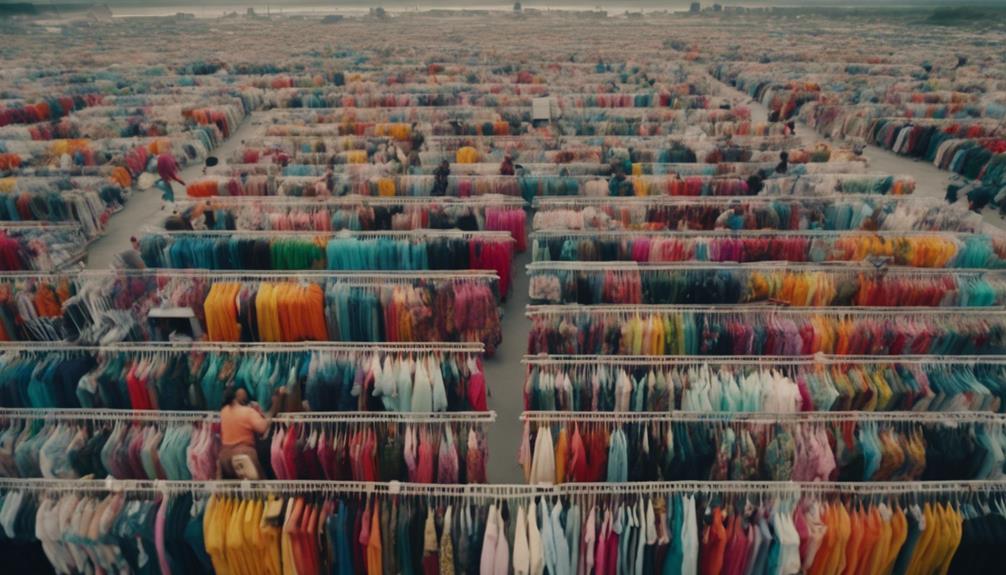
The environmental impact of consumption in the fashion industry is staggering, with fast fashion alone generating an estimated 92 million tons of textile waste each year. Much of this waste ends up in landfills, contributing to growing environmental concerns.
You mightn't realize that approximately 20% of global water pollution comes from textile dyeing and treatment. This highlights the detrimental effects of clothing production on our planet.
When you consider that producing just one cotton t-shirt requires around 2,700 liters of water, it becomes clear how unsustainable conventional clothing manufacturing is. Plus, synthetic fabrics, often used in fast fashion, release an estimated 500,000 tons of microplastics into our oceans every year, harming aquatic life and ecosystems.
As an average consumer in the U.S., you might throw away about 81 pounds of clothing annually. This statistic emphasizes the urgent need for a shift toward more sustainable consumption practices.
The Role of Second-Hand Shopping
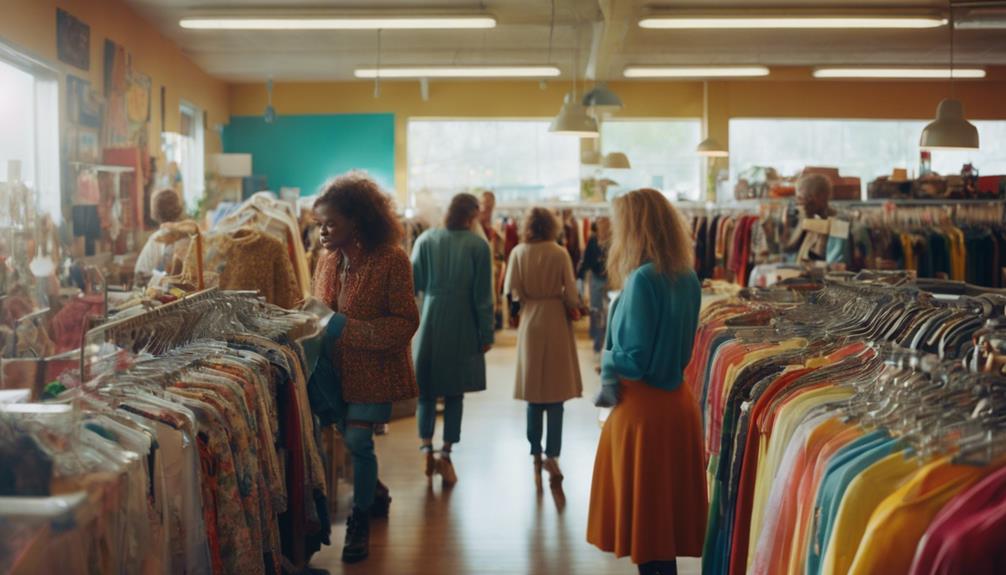
Embracing second-hand shopping not only helps combat the environmental damage caused by fast fashion but also offers a practical way to make sustainable choices that benefit both your wardrobe and the planet. By choosing pre-loved items, you actively participate in a movement that values sustainability and conscious consumerism.
- Extend the life of clothing and reduce waste.
- Enjoy affordable alternatives to new ethical fashion.
- Support local economies and artisans in your community.
The second-hand market is projected to reach $64 billion by 2030, showcasing its increasing popularity as a viable sustainable option. You'll find that purchasing second-hand clothing often challenges the notion that sustainable shopping is a privilege reserved for the wealthy.
This practice not only allows you to curate a unique wardrobe but also emphasizes the importance of buying less and caring for the garments you already own. By integrating second-hand shopping into your lifestyle, you contribute to a more sustainable future while enjoying the thrill of discovering one-of-a-kind pieces.
Rethinking Sustainable Fashion's Image

Rethinking sustainable fashion's image means recognizing that quality doesn't have to come with a hefty price tag, making eco-friendly choices accessible to everyone. Many sustainable brands focus on ethical practices without inflating their prices. You'll find affordable options that prioritize durability and style, proving that you don't have to sacrifice your budget for sustainability.
The rise of the second-hand clothing market further challenges the notion that sustainable fashion is elitist. With projections showing it could reach $64 billion by 2030, you can easily find stylish, pre-loved pieces that align with your values. Plus, online payment solutions like Klarna and Afterpay make it even easier to invest in ethical clothing without feeling the pinch upfront.
Frequently Asked Questions
What Is the Problem With Sustainable Fashion?
The problem with sustainable fashion lies in its higher prices, limiting access for lower-income consumers. You might feel excluded from ethical choices, despite the potential long-term benefits of investing in durable, eco-friendly clothing.
Do Millennials Care About Sustainable Fashion?
Yes, you care about sustainable fashion. With strong values, you prioritize ethical choices and transparency. As a millennial, you're willing to spend more on brands that align with your commitment to the environment and social responsibility.
Do People Really Care About Sustainable Fashion?
You'd think everyone's shouting about sustainable fashion, but reality's different. While many care about it, actual purchasing habits often show otherwise. Cultural conditioning keeps prices low, creating a gap between awareness and action.
Is Sustainable Fashion for the Rich?
Sustainable fashion isn't just for the rich. You can find affordable ethical brands, shop second-hand, and use payment plans like Klarna. Quality and durability often save you money in the long run, too.
Conclusion
In the end, sustainable fashion isn't just for the elite; it's like a bridge connecting our values with our choices.
By embracing a mindset that prioritizes ethical practices and accessibility, you can find ways to support both the planet and workers, regardless of your budget.
Rethinking your purchasing habits and exploring second-hand options can help dismantle the barriers that make sustainability feel exclusive.
Together, we can create a more inclusive future for fashion.









